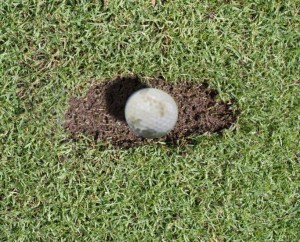
While finding the ball in a divot terrifies amateur golfers, professionals are far more fearful of a ball that’s caked with mud. A “mud ball” is difficult if not impossible to control because the foreign object affects spin in unpredictable ways.
A muddy golf ball will often behave like a baseball pitcher’s knuckleball, fluttering this way and that. Other times, it will veer sharply left or right, or dive out of the sky. As a general rule, the ball will curve in the direction opposite the mud’s placement on the ball. For example, if mud is on the right side of the ball, it will spin and turn left.
The problem is, you can never be quite sure what will happen once a muddy ball leaves the clubface. Therefore, your best bet is to play a low shot with less spin to minimize the mud’s influence. Here’s how.

- Take at least one more club, if not two more, than you usually would from the same distance. (A 6-iron or 7-iron instead of an 8.)
- Play the ball back, around the middle of your stance, with your hands ahead of the clubhead.
- Make an abbreviated backswing and follow through.
The result may not be pretty to watch, but the alterative is hitting a high, spinning shot that could go anywhere. This method at least gives you some control over the outcome.
When conditions are especially muddy, tournament committees will often implement the “lift, clean, and place” rule, allowing you to pick up, clean and replace the ball in the fairway. If you’re playing a casual round with friends, suggest “lift, clean and place” when the turf is soggy. Odds are, you’ll get a unanimous “yes” vote.






